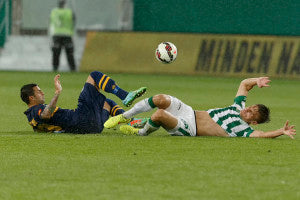EU considering health issues of rubber in artificial pitches reports The Irish Times

Claims that the rubber contains toxic material and may cause cancer have made the safety of the pitches one of the most volatile issues in sport.
The rubber, which is made from recycled and ground down car tyres and used in the construction of "3G" pitches, has been linked to harmful chemicals called PAHs, which are known to be highly carcinogenic (cancer-causing), especially to children.
Based on a proposal by Germany in 2010, the European Commission has put a restriction on the manufacturing, use and placing on the market of PAHs. Companies began to comply with the restriction on December 27th, 2015.
The rubber infill - used in the construction of Leinster Rugby's synthetic pitches in UCD and Donnybrook, as well as a number of GAA grounds, soccer grounds and community pitches around the country, - has been discussed at EU level as a possibly harmful product that should be included in further restrictions.
The GAA said it was aware of the issue. "There is some uncertainty. But we are monitoring the situation, and we are keeping an eye on it," said GAA operations manager Fergal McGill.
Discussion
The most recent discussion about the recycled rubber took place last November at an EU member-state competent authorities meeting.
The European Chemicals Agency (ECHA), which is the driving force behind regulatory chemical authorities in Europe, has begun to prepare a guideline to define which products or parts of products will fall under the scope of European restrictions.
"In early 2015, ECHA started to prepare a guideline to define which articles, or parts of articles, fall under the scope of this restriction," the European agency told The Irish Times.

"This specific issue is still currently open and being considered by the commission. Once the issue has been resolved, ECHA will finalise and publish the guideline."
The Health and Safety Authority (HSA) in Ireland is aware of what has become a polarising debate around claims and counter-claims that the rubber crumb is hazardous. However, it defers to Europe on such matters.
"We are aware there is a discussion at European level on the topic and what can be done about it," said a HSA spokesperson. "These PAH chemicals are known carcinogens. There is clearly an issue over the use of this chemical, and we are part of that."
EU level
"Any move to restrict the use of PAHs in pitches would be an EU level decision, and we are part of that decision-making process."
Artificial "3G" pitches are held in place and cushioned by inserting synthetic grass-like blades into a thin base layer of sand. These blades are then supported by an infill of "rubber crumb" - tiny pieces of rubber sourced from reclaimed tyres.
The pieces stick to sports footwear and clothing, and kick up into the air when players run, slide or dive on the pitch surface.
It is a multifunctional surface, and can be used in almost all weather conditions. It is for those reasons that it has begun to replace natural grass surfaces.
However, minute pieces of the rubber are inhaled, swallowed and graze the skin, with studies in Europe and the US showing links to known cancer-causing agents including chromium, lead and arsenic.
Last week a doctor at England's only FIFA-accredited artificial pitch-testing lab said crumb rubber on "3G" pitches was not dangerous.
Toxicologist Dr Colin Young of Labosport UK, a commercial company dedicated to sports surfaces and equipment, said investigations by his firm showed the rubber - also known as SPR - to be safe.
"We haven't found any toxicological issues or any high elevated levels in any of these materials that are considered a risk to children's health on any SPR fields so far," said Dr Young.
In Ireland there are a number of companies laying synthetic pitches and using the recycled rubber.
"All of the studies show that the infill is not harmful," said a spokesman who did not wish to be named.
"It is a grey area alright, but my conscience would be clear on this. We do a lot of testing of water and that, and the research also says the rubber is safe."
The original article appeared in the THE IRISH TIMES
